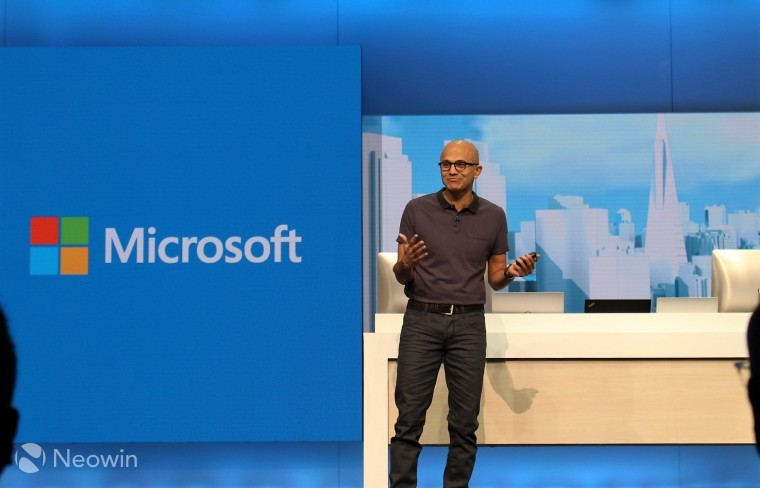Microsoft has published its latest financial results, covering the fourth and final quarter of its 2017 fiscal year (the second quarter of the 2017 calendar year).
The company reported operating income of $7.0 billion non-GAAP ($5.3 billion GAAP) for the three months ending June 30, 2017, on revenue of $24.7 billion non-GAAP ($23.3 billion GAAP). Diluted earnings per share stood at $0.98 non-GAAP ($0.83 GAAP).

Microsoft's continued investments in its Intelligent Cloud services continue to reap rewards for the company, and its ongoing growth in that area has helped pushed the company's stock price to a record high in recent weeks. Microsoft's strong focus on its Office platform, along with the introduction of new tools for businesses and other organizations - such as its Teams collaboration app - have also contributed to its success.
During the last quarter, total revenue in Intelligent Cloud was $7.4 billion, rising by 11% (12% in constant currency (CC)). Revenue from Server products and cloud services rose by 15% (16% CC), while Azure revenue increased by 97% (98% CC). However, Enterprise Services revenue decreased by 3% (1% CC) "with declines in custom support agreements offset by growth in Premier Support Services."
Across its Productivity and Business Processes division, revenue totalled $8.4 billion, an increase of 21% (23% CC), helped considerably by a 43% (44% CC) increase in Office 365 commercial revenue.
It was another strong quarter for Microsoft's Office consumer business too, with Office products and cloud services revenue up by 13% (13% CC). Office 365 consumer subscribers increased from a total of 26.2 million last quarter to 27 million.
Dynamics products and cloud services revenue was up by 7% (9% CC), "driven by Dynamics 365 revenue growth of 74%" (75% CC), while LinkedIn also contributed $1.1 billion in revenue, up from $975 million last quarter. Microsoft completed its acquisition of LinkedIn last December, and by the beginning of its fiscal fourth quarter, the professional networking platform had grown to over half a billion members - an increase of 67 million in 12 months.
Earlier this month, Microsoft announced a new wave of job cuts, removing up to 3,000 people from its global workforce. The latest wave of cuts focuses primarily on the company's global sales teams, as it realigns its sales efforts to focus more heavily on its Azure platform. Given the continued success of Azure - which has grown at a phenomenal rate over multiple consecutive quarters - it's not hard to understand that decision.

Microsoft's More Personal Computing division endured another quarter of mixed results, with overall revenue falling by 2% (1% CC) to $8.8 billion, "driven primarily by lower phone revenue".
Windows commercial products and cloud services were up by 8% (7% CC), a slight increase on the previous quarter's growth. Windows OEM Pro revenue rose by 3% (3% CC), "ahead of the commercial PC market, mainly due to a higher mix of premium devices. Non-Pro Windows OEM revenue was flat. Total Windows OEM revenue increased by 1% (1% CC), "slightly ahead of the overall PC market".
However, after falling by a massive 26% (25% CC) during the previous quarter, Surface revenue decreased by 2% (1% CC) last quarter, which Microsoft attributed to "product lifecycle transitions". Microsoft offered a similar explanation for the previous quarter's revenue decline.
The Surface Book and Surface Pro 4 are both over a year and a half old now, and the 'refreshed' Surface Book with Performance Base didn't fully compensate for the declining interest in those models; the heavily discounted prices on the Pro 4 and first-gen Surface Book in recent weeks will also have had an impact on revenues. While the new Surface Pro tablet and Surface Laptop were unveiled last quarter, they didn't officially launch until mid-June, giving them little time to contribute to the company's quarterly revenues - but the year-over-year decline in Surface revenues is still much smaller than during the previous quarter.
Microsoft posted a second consecutive quarter of growth in its gaming division with revenue rising by 3% (4% CC) across the quarter, "as strength in Xbox software and services offset lower hardware revenue." Xbox software and services revenue increased by a healthy 11% (13% CC), "driven by continued momentum in digital distribution and strong game title performance." The new Xbox One X, which the company announced last quarter, won't arrive until the last quarter of the 2017 calendar year, so we'll have to wait a while before the financial impact of the new console shows up in Microsoft's earnings reports.
Xbox Live monthly active users grew in number to 53 million - an increase of 8% year-over-year, and a rise of 1 million compared with the previous quarter.
It was another strong quarter for the company's search business too, with revenue (excluding traffic acquisition costs) rising by 10% (11% CC), "driven by higher revenue per search and search volume".
Unsurprisingly - given that Microsoft has launched no new mobile devices since its Lumia 650 in February 2016 - it was another terrible quarter for the company's phone business, with revenue declining by $361 million year-over-year. Microsoft described its phone revenue for the quarter as "immaterial".















59 Comments - Add comment